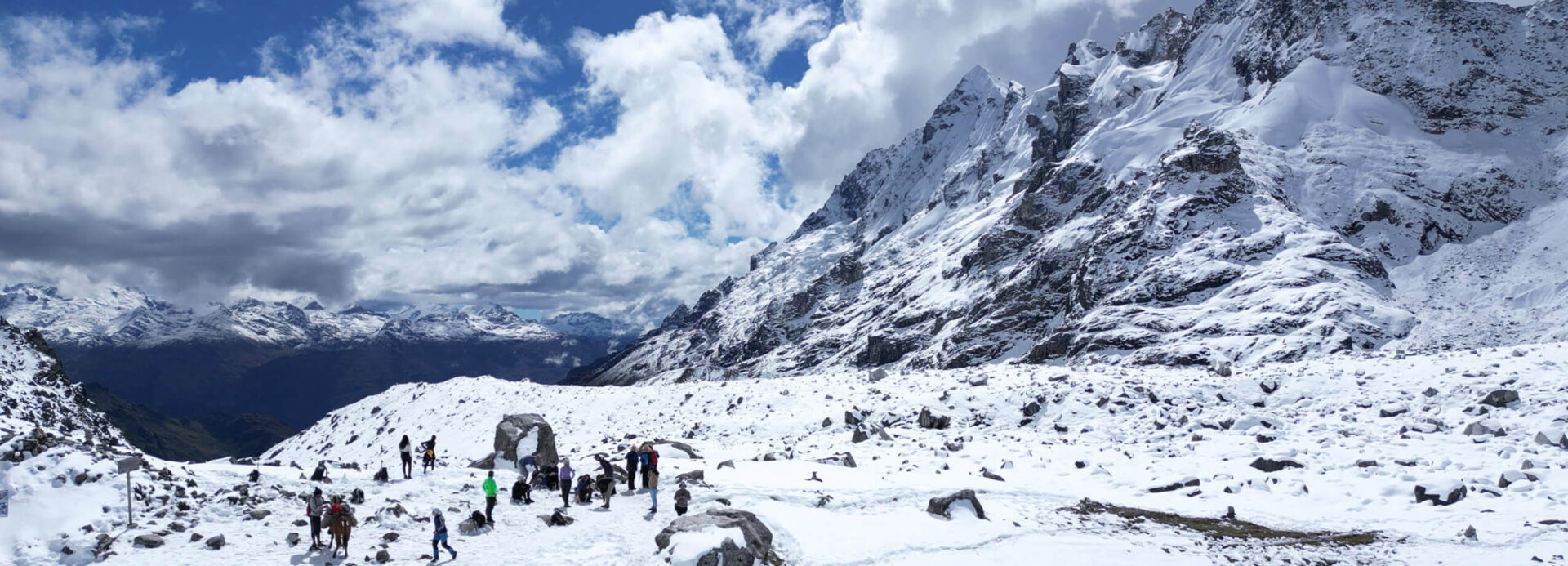A Comprehensive Guide to Salkantay Trail: History, Geography, and Culture Altitude Sickness and Acclimatization Strategies on the Salkantay Trail
Nestled amidst the majestic Andes Mountains of Peru, the Salkantay Trail is a testament to nature’s grandeur and human ingenuity. This ancient pathway is renowned among trekkers and adventurers worldwide and offers unparalleled beauty and cultural richness. As Peru’s #1 tour operator, Alpaca Expeditions is honored to guide travelers through this remarkable landscape, providing insight into its history, geography, and cultural significance.
The Salkantay Trail has earned its place as a favorite among trekkers, offering an alternative route to the iconic Machu Picchu. Its popularity stems not only from the breathtaking vistas and challenging terrain but also from the opportunity it presents to immerse oneself in the heritage of the Inca civilization.
Understanding the Trail’s history, geography, and cultural significance is paramount, as it enriches the trekking experience and fosters a deeper appreciation for the land and its people. Join us as we embark on a journey to uncover the secrets of the Salkantay Trail, where adventure and exploration await at every turn.
History of the Salkantay Trail
The history of our Trail traces back to the ancient Inca civilization, where it held significant importance as a vital trade and pilgrimage route. As one of the many networks of trails constructed by the Incas, our Trail served as a crucial link between the highlands and the lowlands, connecting various regions of the vast Inca Empire.
While the renowned Inca Trail is celebrated for its direct path to Machu Picchu, our Trail emerged as an alternative route, offering trekkers a more challenging yet equally rewarding journey to the famed citadel. Over the centuries, the Trail garnered recognition for its breathtaking scenery, diverse ecosystems, and cultural significance, attracting adventurers seeking an off-the-beaten-path experience.
However, the arrival of the Spanish conquistadors in the 16th century marked a significant turning point for the Trail. The Spanish colonization led to the decline of the Inca Empire and the abandonment of many of its routes, including our Trail. With the imposition of new socio-political structures and the introduction of Christianity, the Trail’s significance diminished and faded into obscurity for centuries.
Despite the impact of Spanish colonization, the Trail endured, was preserved by local communities and was eventually rediscovered by modern-day explorers. Today, it stands as a testament to the resilience of Inca heritage and continues to captivate travelers with its rich history and awe-inspiring beauty.
Geography of the Salkantay Trail
The Salkantay Trail, renowned for its breathtaking beauty and challenging terrain, spans approximately 74 kilometres (46 miles) from Mollepata, a small village in the Peruvian Andes. This ancient footpath leads trekkers through some of the most awe-inspiring landscapes in the region.
As adventurers embark on their journey, they are immediately greeted by the imposing presence of Salkantay Mountain, the highest peak in the Vilcabamba Range and a sacred entity in Inca mythology. The Trail winds its way through diverse terrains, ranging from rugged mountain passes adorned with snow-capped peaks to verdant valleys blanketed in emerald foliage.

One of the most striking features encountered along the route is the Humantay Lake, a glacial lake nestled amidst towering peaks, offering a serene reflection of the surrounding landscape. Additionally, trekkers traverse through pristine cloud forests, where lush vegetation thrives in the misty, high-altitude environment. The Trail also provides glimpses of traditional Andean communities, allowing travelers to immerse themselves in the region’s rich cultural tapestry.
Overall, the geography of our Trail offers a captivating blend of awe-inspiring natural wonders, cultural heritage, and challenging terrain, making it a truly unforgettable adventure for those who dare to explore its path.
Cultural Significance of the Salkantay Trail
The Salkantay Trail holds profound cultural significance deeply rooted in Inca mythology and religious practices. For the ancient Incas, the Trail was not merely a means of transportation but a sacred pathway connecting the earthly realm with the divine. Known as the “Path of the Salkantay,” it was revered as a spiritual journey leading pilgrims to the sacred city of Machu Picchu, believed to be the residence of the gods.
Throughout the Trail, one encounters sacred sites, ritual offerings, and remnants of ancient ceremonies, underscoring its importance in Inca spiritual beliefs. The towering Salkantay Mountain was worshipped as an apu, or mountain deity, symbolizing protection and fertility.
Despite centuries of cultural transformation and modernization, efforts to preserve the cultural heritage of the Salkantay Trail remain steadfast. Recognizing its intrinsic value, conservation initiatives seek to safeguard its sacred sites, protect its natural surroundings, and promote sustainable tourism practices.
By honoring and preserving the cultural legacy of the Salkantay Trail, we not only pay homage to the wisdom and traditions of the ancient Incas but ensure that future generations can continue to connect with its spiritual essence and historical significance.
Altitude Sickness: Understanding the Risks
Altitude sickness, also known as acute mountain sickness (AMS), is a condition that can affect individuals when they ascend to high altitudes too quickly, such as those encountered along with us. Symptoms of altitude sickness may include headaches, nausea, fatigue, dizziness, and difficulty sleeping. As trekkers ascend along the Salkantay Trail, the altitude gradually increases, posing a risk for altitude-related illnesses.
The thinning air at higher elevations reduces oxygen levels, putting strain on the body’s respiratory and circulatory systems. Failure to acclimatize properly or ignoring symptoms of altitude sickness can lead to more severe conditions like high altitude pulmonary edema (HAPE) or high altitude cerebral edema (HACE), which can be life-threatening.
Recognizing the signs of altitude sickness and taking appropriate measures, such as resting, hydrating, and descending if necessary, are crucial for ensuring a safe and enjoyable trekking experience. Alpaca Expeditions prioritizes the well-being of its clients and provides expert guidance on altitude acclimatization to mitigate the risks associated with high-altitude trekking.
Acclimatization Strategies for the Salkantay Trail
Preparing for high-altitude trekking along the Salkantay Trail requires careful consideration and planning to ensure a safe and enjoyable experience. Firstly, it’s crucial to gradually acclimate to the altitude by allowing your body time to adjust to the reduced oxygen levels. Begin your trek with moderate physical activity and gradually increase intensity over the first few days. Incorporate rest days into your itinerary to aid acclimatization.
Staying hydrated is paramount at high altitudes to prevent altitude sickness. Drink plenty of water throughout the day, even if you don’t feel thirsty, and avoid excessive caffeine and alcohol consumption, as they can contribute to dehydration. Maintaining a balanced diet rich in carbohydrates, proteins, and essential nutrients will give your body the energy it needs for the trek while supporting overall health and acclimatization.
Finally, prioritize adequate rest and sleep each night to allow your body to recover and adapt to the altitude. Listen to your body; don’t hesitate to slow down or take breaks as needed. Following these acclimatization strategies will optimize your chances of a successful and enjoyable trek along the Salkantay Trail.
Conclusion:
In conclusion, the Salkantay Trail Peru is a testament to Peru’s rich history, breathtaking geography, and profound cultural heritage. From its origins as an ancient Inca pathway to its significance as a modern-day trekking route, the Trail weaves centuries of stories and traditions together. As trekkers venture along its rugged terrain, they are immersed in the stunning beauty of the Andean landscape, from towering peaks to verdant valleys.
However, embarking on the Trail requires more than just admiration for its natural wonders; it demands careful preparation and awareness of potential challenges, particularly altitude sickness. Adventurers can ensure a safe and enjoyable journey to Machu Picchu by understanding the risks and implementing appropriate acclimatization strategies.
At Alpaca Expeditions, we invite you to join us on this extraordinary adventure. With our expert guides, personalized service, and commitment to sustainability, we promise an unforgettable experience along the Salkantay Trail.
Whether you’re seeking a cultural immersion, a physical challenge, or simply a chance to reconnect with nature, our team is dedicated to making your trek a once-in-a-lifetime journey So pack your bags, lace up your boots, and get ready to explore the wonders of Peru with Alpaca Expeditions by your side. Your next adventure awaits!
Alpaca Expeditions Recognitions
ISO (International Organization for Standardization)
In the pursuit to stand out from the rest, Alpaca Expeditions has obtained four ISOs plus our carbon footprint certificate to date. These achievements result from our efforts to implement the internationally-recognized integrated management system. They also represent our commitment to all of our clients and staff of operating sustainability and responsibility in every way possible.




































 Porters will carry up to 7 kg of your personal items, which must include your sleeping bag and air mat (if you bring or rent one). From us, these two items weigh a combined total of 3.5 kg.
Porters will carry up to 7 kg of your personal items, which must include your sleeping bag and air mat (if you bring or rent one). From us, these two items weigh a combined total of 3.5 kg.

